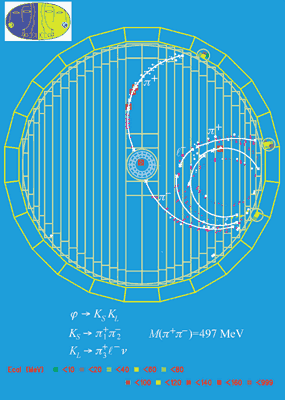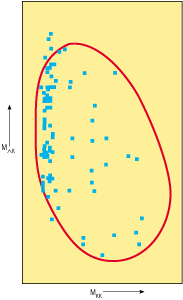The first kaons from the new DAFNE phimeson factory at Frascati underline a fascinating chapter in the evolution of particle physics.

As reported in the June issue, in mid-April the new DAFNE phi-meson factory at Frascati began operation, with the KLOE detector looking at the physics.
The DAFNE electronpositron collider operates at a total collision energy of 1020 MeV, the mass of the phi-meson, which prefers to decay into pairs of kaons. These decays provide a new stage to investigate CP violation, the subtle asymmetry that distinguishes between matter and antimatter. More knowledge of CP violation is the key to an increased understanding of both elementary particles and Big Bang cosmology.
Since the discovery of CP violation in 1964, neutral kaons have been the classic scenario for CP violation, produced as secondary beams from accelerators. This is now changing as new CP violation scenarios open up with B particles, containing the fifth quark “beauty”, “bottom” or simply “b” (June).
Although still on the neutral kaon beat, DAFNE offers attractive new experimental possibilities. Kaons produced via electronpositron annihilation are pure and uncontaminated by background, and having two kaons produced coherently opens up a new sector of precision kaon interferometry. The data are eagerly awaited.
Strange decay
At first sight the fact that the phi prefers to decay into pairs of kaons seems strange. The phi (1020 MeV) is only slightly heavier than a pair of neutral kaons (498 MeV each), and kinematically this decay is very constrained. At first sight, phi decay via a rho-meson (770 MeV) and a pion (140 MeV) should be easier.
The phi-meson was first seen in bubble chamber experiments at Brookhaven in 1962. A subsequent paper, published the following year, outlined the properties of the new particle.

In 1963 the name of the game was to assign particles into SU3 multiplets, the Eightfold Way of Gell-Mann and Ne’eman. SU3 had to be some reflection of an underlying symmetry. At the time, physicists had little idea what this symmetry was, other than that it had to have a threefold structure. Quarks had not yet been talked about.
The 1963 paper said that the phi was a “vector” (spin-one, negative parity) meson. It could be accommodated as an SU3 singlet, supplementing an octet of other vector mesons, the rho and its cousins.
George Zweig, just completing his PhD at Caltech under Richard Feynman, looked at the paper and was immediately intrigued by the huge signal for the decay into two kaons, right at the edge of the kinematically allowed region, while the apparently easier rhopi decay was suppressed.
“Feynman taught me that in strong interaction physics everything that can possibly happen does, and with maximum strength,” said Zweig. “Only conservation laws suppress reactions. Here was a reaction that was allowed but did not proceed.”
Feynman taught me that in strong interaction physics everything that can possibly happen does, and with maximum strength.
George Zweig
This worried Zweig, who had been quietly toying with the idea that perhaps strongly interacting particles had constituents. The bizarre decay behaviour of the phi convinced him that constituents made sense. Moreover, he felt that, instead of being just some mathematical symmetry reflected as SU3 multiplets, these constituents had to be real.
His idea was that the phi has something in common with the kaons, but not the rho and the pi. This constituent, whatever it is, has to survive phi decay, and this can only be done by producing kaons, which are known to carry the quantum number strangeness.
This legacy of the phi we now call the strange quark the phi contains a strange quarkantiquark pair. When the phi decays, the strange quarks have to go somewhere, and the kaon route is the only possibility: the strange quark goes into one neutral kaon and the strange antiquark goes into a neutral kaon antiparticle.
Gell-Mann had focused on a threefold underlying symmetry and had pounced on the “quark” word from a call at the bar in James Joyce’s Finnegan’s Wake: “Three quarks for Muster Mark”.
Trying to sell his quark ideas, Gell-Mann recalled his earlier experience, when he had invented the name “strangeness” for a new quantum number. Physicists were used to dealing with particles denoted by Greek letters. If a new word had to be invented, they looked for derivations from classical Greek. Not Gell-Mann, who had gleefully flung his unorthodox “strangeness” into the arena and was accused of being frivolous. Remembering those difficulties, Gell-Mann, working in the US, sent his quark paper to the European journal Physics Letters, where it was published in 1964.
Four aces
However, in 1963 Zweig did not know about the quark ideas then going around in Gell-Mann’s head. Zweig thought that there should be four constituents (because there were four weakly interacting particles, or leptons) and called them “aces”. After leaving Caltech, Zweig worked at CERN for a while, bringing his aces idea with him. His paper appeared as a CERN internal preprint in January 1964. Wanting to publish in a US journal, Zweig came under pressure from CERN to publish in Europe. However, with no reputation, his idea fell on infertile ground and his paper was not widely published until several years later, when the value of his ideas had been recognized and the CERN “aces” preprint reproduced.
In Israel in the the early 1960s, Yuval Ne’eman and Haim Goldberg also concocted a threefold underlying symmetry pattern, but it too fell by the wayside, despite being accepted for publication.
Zweig’s suspicion that there were four basic constituents, rather than three, was ahead of its time, anticipating the elucidation and discovery of the fourth quark “charm” in the early 1970s.
Later, Zweig wrote: “The reaction of the theoretical physics community to the ace model was not benign. Getting the CERN report published in the form I wanted was so difficult that I finally gave up.”
Despite the demise of the ace picture, Zweig’s contributions are still remembered. The selection rule that recognizes that constituent quarks have to survive (for example that phi prefers to decay into two kaons) is called the “Zweig rule”.
Zweig subsequently turned his talents to research in sensory physiology, where, in 1975, his work led to the development of what is now called the continuous wavelet transform a way of displaying and extracting time and frequency information in a signal. More recently he has proposed a model of cochlear mechanics that predicts that the ear makes sounds when it listens to sounds. These predictions were confirmed in experiments. He became a fellow of the US Los Alamos National Laboratory in 1985.








